Like most casual gun owners, I spent a long time not wanting to spend a lot of money on optics. I think this is typical behavior of gun owners who do a lot of static shooting; we want to throw all that money into cool-looking guns, not on scopes and reflex sights. I mean, there’s lots of cool-looking, cheap reflex sights and scopes with lots of features, right? And glass is glass! How big a deal is it?
And, the same as everyone else, that erroneous line of thinking gets dispelled the second you look through a really good reflex sight or scope. For me, those were the Mepro RDS and the Sig Tango6 3-18×44. They just blew me away compared to the cheaper Chinese optics I had been using, and made me realize there was an actual performance advantage in having that stellar glass and tracking. Combine that with wanting to shoot at a much higher performance level, and you’ve got a recipe for willingness to throw a lot more money into optics.
This leads me to today, where I’ve put down the money on a Vortex Razor Gen III 1-10×24 scope with MOA/BDC reticle. In terms of both street price and MSRP, it’s the most expensive scope I own. On the other hand, it’s also going on the rifle I plan to shoot the most, in a competitive environment, so is it money well-spent? Read on.
I bought the Razor Gen3 from MK Machining as part of a mount (Warne RAMP) and level bundle for the usual $2000 street price. Ironically, I am not using either the mount or the level with the scope, even though both are quite good.

The scope comes in a very large, fancy box with the scope, branded Switchview lever, product manual, reticle manual, scope tool, sunshade, inspection/warranty card, and probably other things I’m forgetting. The presentation is pretty spectacular; I guess when you drop a couple grand on a scope, there’s an expectation that you’re going to get coddled a bit. Vortex has got you covered.
However, there were no flip-up caps! I had a spare 24mm objective cap lying around, and bought a Vortex Defender eyepiece cap off Amazon. I know some product marketing guru is going to tell me “that’s so you can buy your own”, but let’s face it, I kind of expect SOMETHING at this price point.
Aesthetics: The Razor Gen3’s most defining characteristic on the outside is its color. The color is “Stealth Shadow”, and it’s kind of a weird light purple-bronze color. I am absolutely a member of team black so this wasn’t my favorite choice, but rest assured that every single person around you will know you are shooting a Razor, because there is no other scope with quite the same color. Otherwise, it is remarkably compact and light-weight for being a 1-10x scope, but eschews any other obvious styling besides some tasteful knurling on the turret caps and magnification adjustment ring. People who aren’t looking closely will probably assume it’s a Razor Gen II-E.
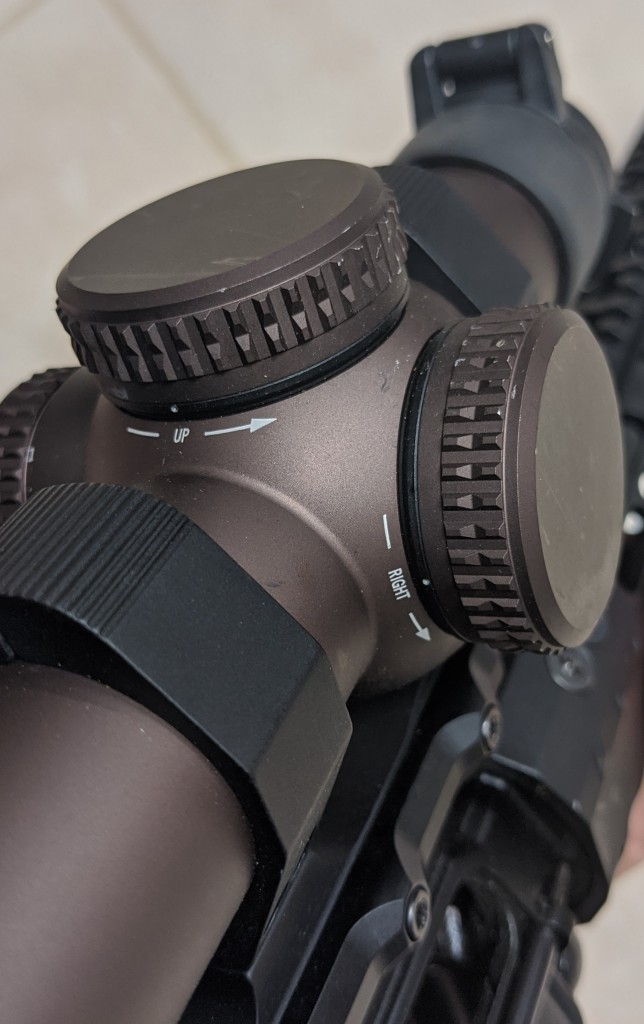
One change was that the Gen3 moved to a 34mm tube… so you’ll need a new mount. I’m a man of simple taste, so I used an Aero standard mount I had on hand. If you’re buying new, I’d recommend the SPR mount for more flexibility in placement.
Controls: No surprises here; just capped turrets (1/4 MOA clicks), a locking illumination knob, a knurled magnification adjustment ring, and diopter adjustment on the eyepiece. No objections to the clicks or resistance, except…
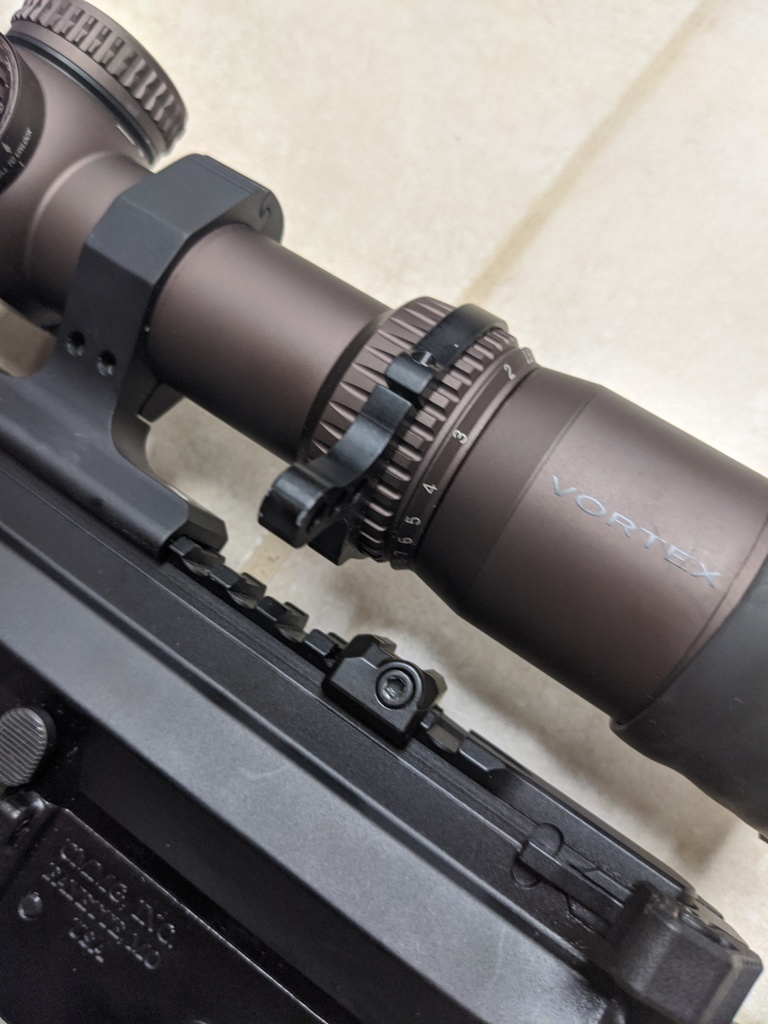
I know there has historically been some complaining that the magnification adjustment ring on the Vortex Gen2 was too stiff; if anything, Vortex may have gone a little too far in the other direction, because it was a little too easy to bump the magnification adjustment off 1x when I was carrying the rifle slung and running around with it. Mind you, this was WITH the included Switchview lever on it in the 9-3 rotation position, but I’d suggest giving it a quick check before you get shooting if you’re depending on it being at the bottom of the magnification range. It’s super smooth, and this problem won’t occur without the Switchview lever being installed, or if you put it at a 7.5-1.5 rotation, but just be aware of it.
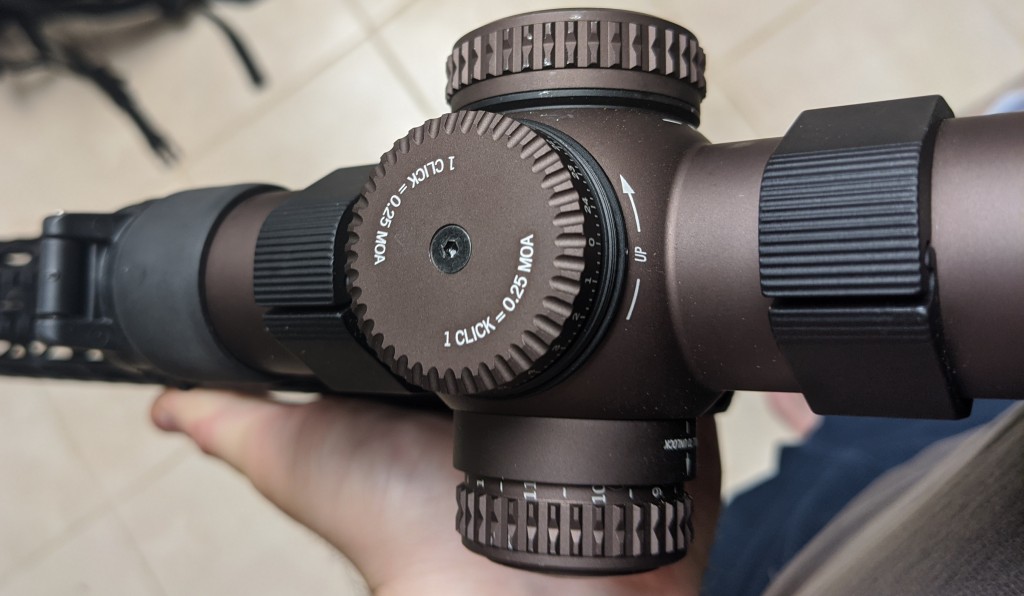
Zero reset worked as expected. You unscrew a 2mm screw, lift up the turret, and then put it down with zero in the right spot. Pretty easy stuff. At the time of this review, ammo has become a little trickier to find due to COVID-19 panic buying, so one coping mechanism is to keep your scope zeroed to your primary load, and then keep temporary zeroes for the ammo you’re forced to shoot otherwise.
Optics: This optic has fantastic glass. Clarity-wise, it is as good or better than my Bushnell SMRS 1-8.5x, which had some pretty rocking glass for its day (and even these days!). It is a smidge better than my Whiskey5 1-5×24, too. Clarity was excellent all the way up and down the magnification range. Eyebox was similarly great – if you do your homework when you first set the scope up on your rifle, 10x from the shoulder is very doable.
Parallax is fixed at 150yds. This is NOT a freebie. There is slightly more blurriness at very close ranges as a result. But if you’re trying to shoot out past 600yds, it will provide some marginal advantages over the Gen2’s 100yd parallax. Short of implementing adjustable parallax – which might not have been a bad idea – this is probably the best they could have done.
The 24mm objective is often regarded as a weak point in this scope. Obviously, larger objectives are generally a better thing for light collection. I will say that I didn’t notice it much, but I’m also not doing much late evening shooting.
People online don’t seem to understand this, but I’ll say it anyways: every product has design trade-offs. I assume Vortex didn’t include adjustable parallax and a larger objective due to weight and cost targets. Maybe we’ll see a Gen III-LR that includes those features and an exposed locking elevation turret in the future?
Illumination: The illumination scales linearly, and at top end, it is “Aimpoint bright”, which is to say, brighter than almost all of my reflex sights. Illumination has a locking turret; this is the first time I think I’ve seen that, but it’s standard on the Razor line. I guess you can rest assured that your illumination is going to stay on whatever setting you’ve chosen.

Something I don’t see discussed too often is that the Gen III has a different illumination paradigm than the the Gen II. The Gen II used a fiber optic system; the Gen III has reflected illumination that’s much like the Leupold Mk6. One downside of the new system is if you manage to move your head off axis enough, you’ll see the illumination partially or even completely disappear. The problem is mostly alleviated if you turn the brightness a notch or two beyond where it needs to go. This isn’t a big deal, and the brightness payoff seems worth it, but it’s something to keep an eye out for. There is also an oddity with tops of the “sixes” in the reticle getting some unexpected illumination (Vortex says this is normal). This looks weird, but has no impact when using the scope in the real world – you will never notice.
Reticle: The Razor Gen III comes with two different reticles: an MRAD Chanukah bush reticle, and an MOA BDC reticle. I have the latter. They are not so dissimilar in concept – front focal plane, 1 MOA dot, 5.5 MOA semi-transparent broken circle aiming aid, ranging scale on the top, MOA/milrad hashes on the horizontal line, and some sort of ranging marks and windage marks on the lower vertical line. The milrad reticle uses mils, the MOA reticle uses BDC for 55gr @ 3150fps (aka, M193 out of an 18″ barrel).

The MRAD reticle is more flexible; the MOA reticle is going to be faster to use with the right rifle/ammo combination. It is essentially a multi-gun competition reticle, and in my opinion, quite well designed for that purpose, especially as you get to the 5-10x zoom range where the holdovers become easier to use. The ranging estimation scale on the MOA reticle is set up for standard IPSC/USPSA targets. One other thing I very much liked about the MOA reticle was that instead of trying to be dumb and give you 700 and 800yd holdovers (which are going to be right for almost no one’s rifle), Vortex instead just goes back to regular MOA holdover marks, starting at 24. This isn’t quite genius, but it’s still a clever idea.
Since the Gen III has front focal plane that scale appropriately to magnification, one very common question is “do they work well at 1x without illumination?” The answer is “yes, depending on your target”. Running it with illumination still seems to make it much faster for the eye to pick up, but I don’t think you’d be out of luck if your battery ran out, unless it was a dark target or perhaps a darker environment. I absolutely believe Vortex designs their reticles around their brightness capabilities, and I think that’s a fair way to go about it.
One thing that is worth pointing out, however, is that you have a de facto 5.5 MOA illuminated dot on 1x resolution due to how the “broken circle” aiming aid scales down. If you are one of those shooters who insists on shooting at 1x as much as possible at longer distances, you could be covering more of the target than you’re used to. On scopes like the Razor Gen2 JM-1 and C-More C3, you are going to have a smaller ~1MOA aiming point instead. I am surprised more people aren’t talking about this, because it’s probably the Razor Gen3’s biggest weak spot for most users. I really found myself wishing they had simply gone with a 1MOA dot in the middle and not bothered with the circle of death. Perhaps Vortex’s FFP illumination tech wasn’t up to making that small of a dot nuclear bright.
Testing Platform: The Katana, which is my tuned multi-gun AR.
Testing: My first experience with the Razor Gen3 was at a semi-private shooting class. Before I go further, I want to reveal some important information: I’m cross-eye dominant. Shooting both eyes open is hard for me, especially when something other than raw target focus is necessary.
I found that on “up” drills where you put the rifle on target and fire from a low-ready, the Razor Gen3 gave up almost nothing to a reflex sight. Your eye comes into the eyebox, the illuminated dot pops up on target, and you pull the trigger. Easy.
I had slightly more difficulty with two and three target transitions and getting my transition times below .4s while keeping acceptable accuracy. Mind you, most of this was my technique, so I don’t want to overstate the issue, but I’ve been faster with a reflex sight. Anyone who tells you that an LPVO functions just like a reflex sight at 1x is a liar or has never used both. I just had trouble keeping the eyebox where it needed to be. I don’t think this was because it was small, either.
We did some VTAC barricade work on 25yd targets, and I didn’t feel like the eyebox was problem for this. Getting down low on the gun was not particularly troublesome, and neither were awkward positions.
Finally, we did a 50-300yd walkback drill, and I was quite impressed with the Vortex’s clarity and holdovers. I had a rough 50yd zero, and it was trivial to make 300yd steel hits with the 300yd holdover from a stable position. Prone shooting was similarly easy due to the eybox – and given that fat guy prone is hard with a lot of scopes, this was a nice discovery.
The 5.5 MOA dot DID cause me some issues trying to ping smaller steel on 1x. One of my instructors had no idea why I seemed to want to zoom in sooner than him, and I think the amount of steel my dot was covering was partly to blame. This is a somewhat niche problem, but I could see it coming up if you run a lot of 75yd arrays with smaller targets at matches. YMMV.
My second trip out was to refine my zero and see just what I could do in terms of shooting groups. This isn’t what the scope is designed for, but I was curious to see what having that extra magnification would do for me in a more controlled environment.
Suffice it to say, it was a real hole puncher at 100yds and in. Punching out 1″ circles was trivial from a rest at 50yds, and it was a pleasure to shoot offhand, so long as illumination was turned on. On a cloudy day, I had the illumination on at about 7, and found that to be more than adequate.
Next, I ran it at a private carbine/pistol class at AGC. With the reticle illuminated at setting 8, on a very bright sunny day, it performed VERY well. Most of the rifle shooting was done on 50-75yd target arrays, some of which were AC-sized steel (aka, close to the the Vortex 1-10x’s worst case scenario).
I will say… it worked pretty well. Better than I expected. I actually shot some of the same drills with my class carbine with a reflex sight AND the Katana, so I have a pretty good idea of the difference in feel. The reflex sight just wasn’t much faster to get on sight with. I really found more of the performance difference was due to the carbine not having a brake/comp and slowing down follow-up shot performance.
Finally, I ran it at a 3gun match on a really hot 90 degree day near Baltimore. This is, after all, a competition optic, and no review is really complete without testing it in this context. It worked quite well (even if my own performance was a bit substandard), and I cannot say there were any situations where I felt like I wish I had a reflex sight instead. I will say I did feel like the larger center dot did get in the way of some the smaller distance targets during the 200yd stage, but cranking up the magnification did resolve that. (Turning down or even off the brightness might also have helped.) This would not have been as much of an issue with something like the Razor Gen II, which has a much smaller center dot. I noticed a bit of chromatic aberration at 200yds when I cranked up the zoom; I didn’t really regard it as a big deal or impacting performance, but if you’re looking for zero CA on hot days, this may not be what you’re looking for. (If you are running in Open division, you can just mount up a 2-3 MOA red dot to avoid this problem, of course.)
ETA (9/18/2020): While at the PNTC 2gun tournament yesterday, I used the BDC on this optic to make multiple 460yd first round hits on 12″ steel. So I would say the BDC works just fine.
Conclusions: The Vortex Razor Gen III is an amazing scope. Vortex deserves a ton of credit for really pushing forward the state of the art, and they’ve produced a scope that is not quite like anything else. It’s not “the best” at anything, but the sum total of the capabilities lets it punch above its price point.
There are definitely things I might change, but unlike most other products I review, these changes feel like legitimate design trade-offs rather than missed opportunities. If there is any over-arching critique of the scope to be had, it’s that it’s not quite as good at 0-200yds on 1x (ie, point blank distance) as the Vortex Razor GenII-E due to the longer fixed parallax distance and the larger illuminated dot. But once you get out to 300yds, it has few equals, and the hit you take closer-in is just not that big a deal against most targets.

If you’re not shooting past 400yds, ever, don’t bother selling your Razor Gen II-E; you won’t gain much if anything from the Gen III. If you need to take on 500yd+ shots, the Gen III provides a real competitive advantage. I suspect that really dedicated 3gunners may very well opt for both, and use one or the other depending on the match’s targets (using QD mounts).
And, of course, if you’re just looking for the best do-it-all “tactical” LPVO under $2000, the Vortex Razor Gen3 is your ticket. I know that sounds like a huge chunk of change for most people, and it is, but you are getting your money’s worth.


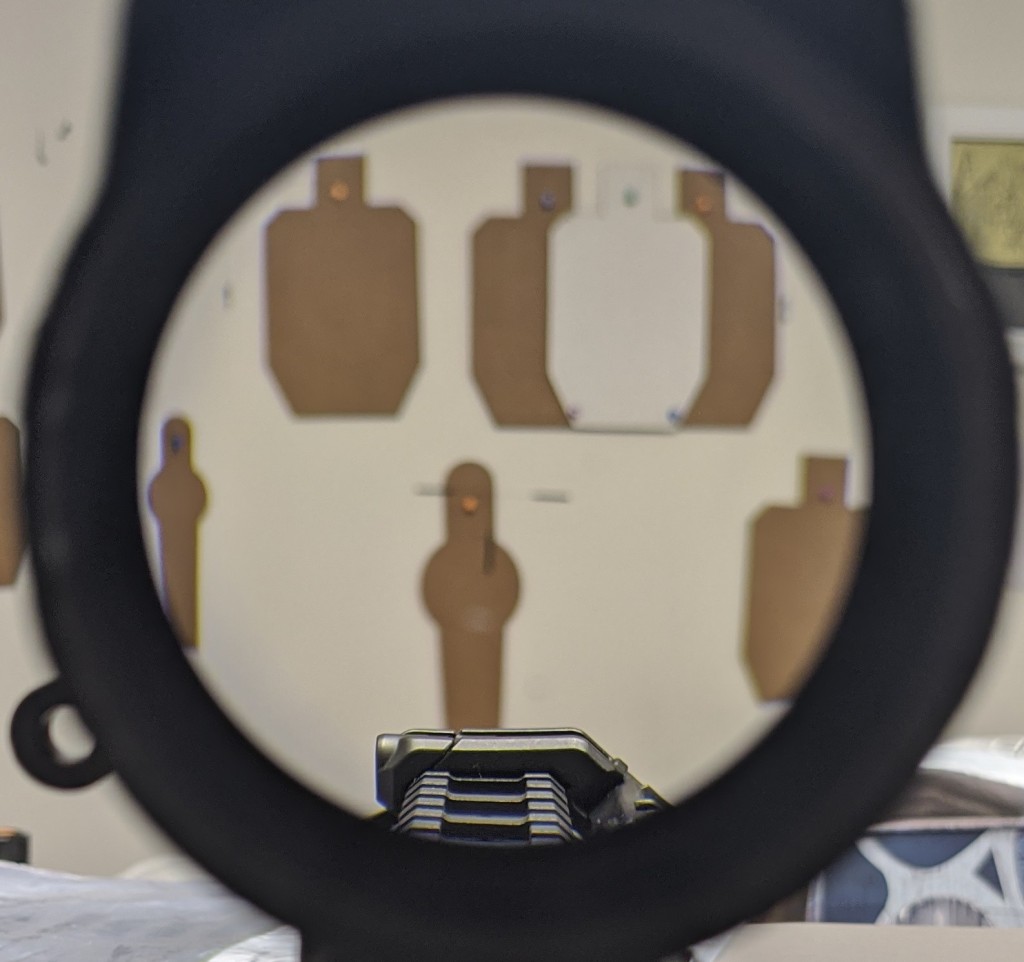
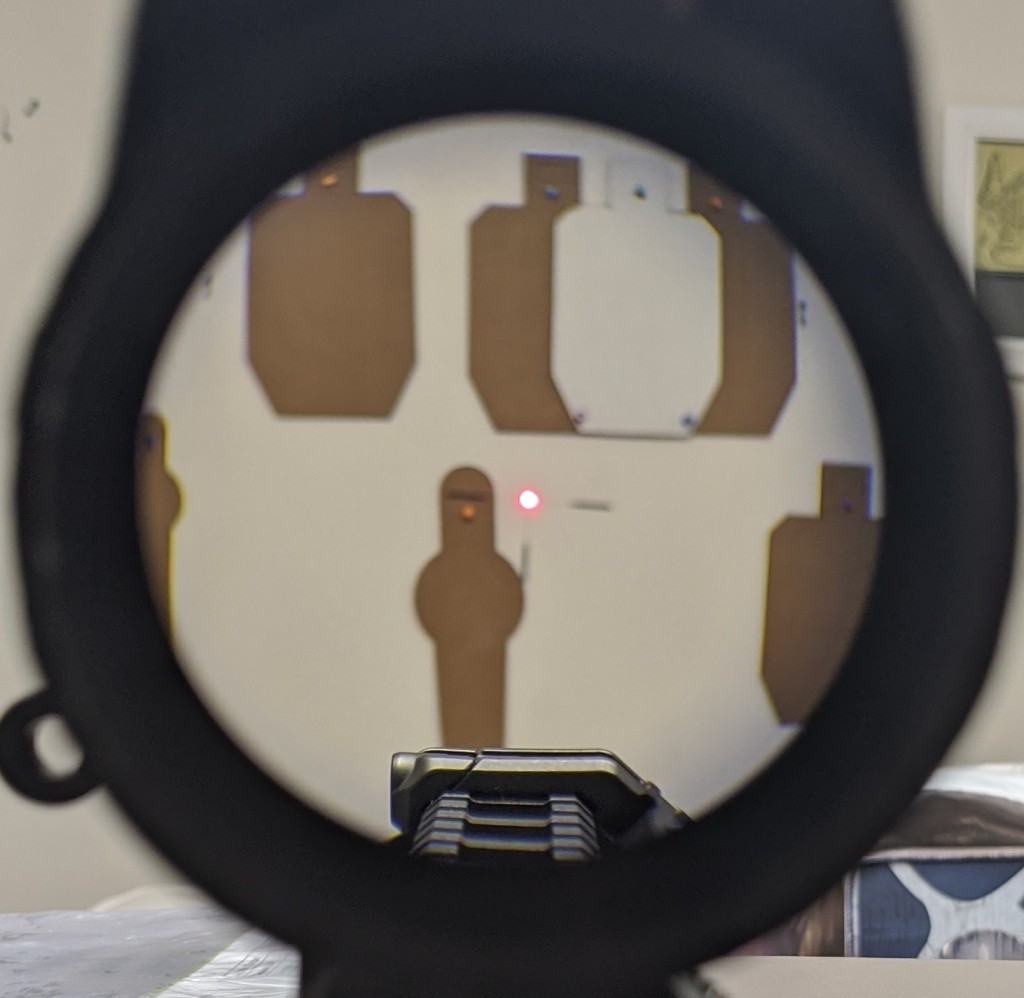

Wow, the Razor Gen III 1-10×24 sounds like a beast of a scope! I’ve always been impressed with Vortex scopes‘ glass quality, and it seems they’ve outdone themselves with this one. The clarity and eyebox you describe are incredible, especially at 10x. I’m also intrigued by the reticle design for multi-gun competition. It sounds like a dream for fast target acquisition and precision shooting. Thanks for the thorough review, I’m seriously considering this LPVO for my next build!
LikeLike